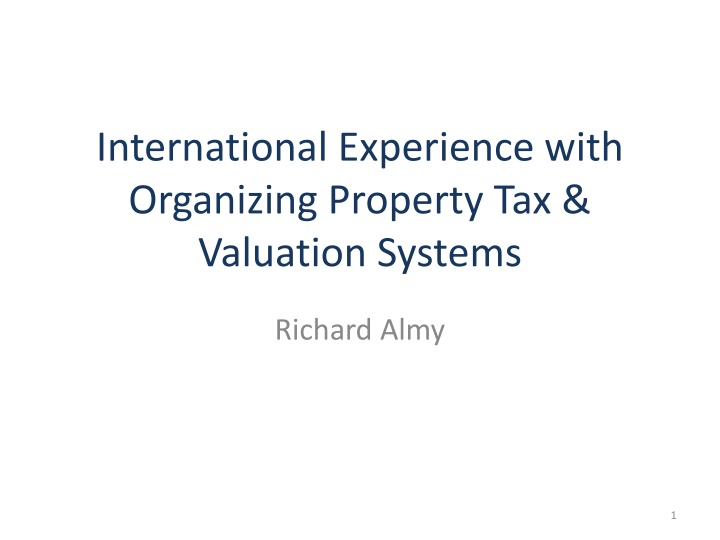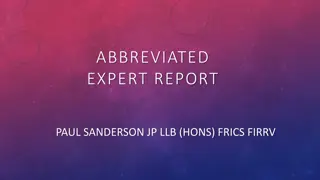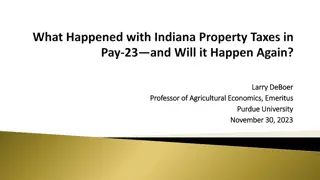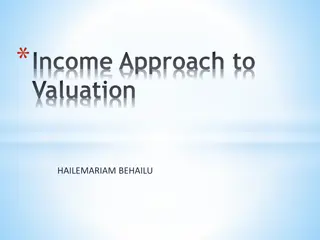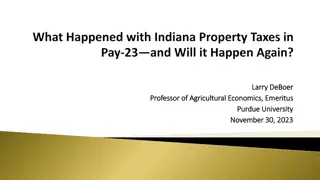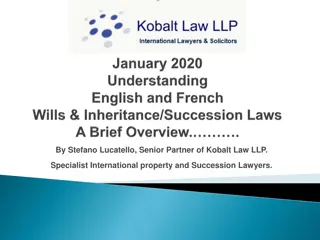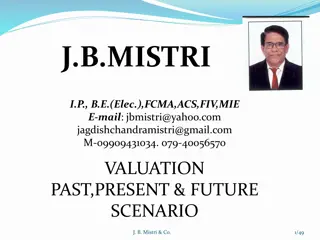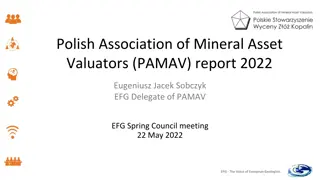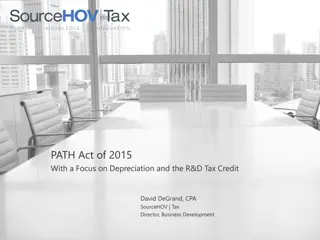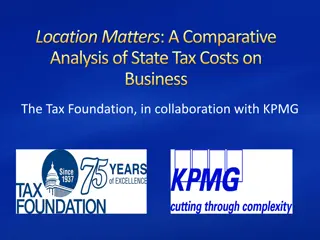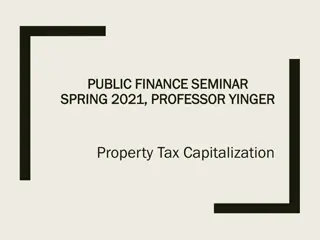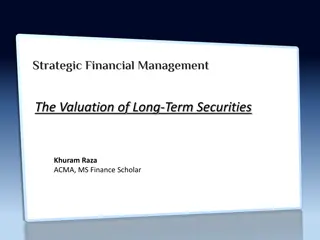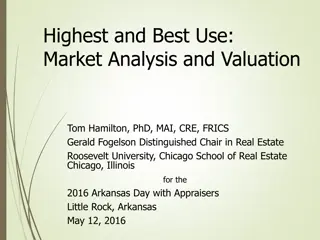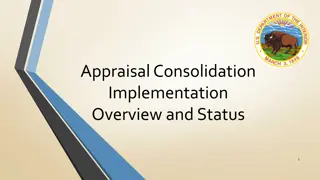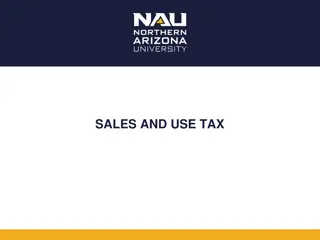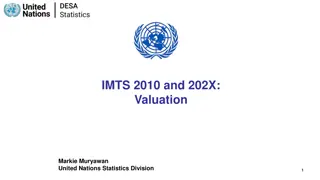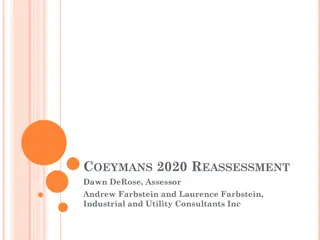International Experience with Organizing Property Tax & Valuation Systems
The world of property taxation and valuation systems, covering types of property taxes, valuation concepts, cost-efficient taxation, mass valuation processes, and system requirements. Discover insights, achievements, and considerations for effective property tax administration.
Download Presentation

Please find below an Image/Link to download the presentation.
The content on the website is provided AS IS for your information and personal use only. It may not be sold, licensed, or shared on other websites without obtaining consent from the author.If you encounter any issues during the download, it is possible that the publisher has removed the file from their server.
You are allowed to download the files provided on this website for personal or commercial use, subject to the condition that they are used lawfully. All files are the property of their respective owners.
The content on the website is provided AS IS for your information and personal use only. It may not be sold, licensed, or shared on other websites without obtaining consent from the author.
E N D
Presentation Transcript
International Experience with Organizing Property Tax & Valuation Systems Richard Almy 1
Background Types of property taxes Recurrent taxes IMF has X categories example: an annual real estate tax (land taxes, building taxes, real estate taxes, combinations) Sporadic taxes IMF has Y categories Main one is taxes on transfers of property Value & valuation concepts Value is subjective an opinion Value depends on what is being valued & on what the valuation will be used for taxation, for example Valuation credibility & valuation standards 2
Valuation for Taxation Should be cost-efficient Adam Smith s 4th canon The Swedish concept of ambition Value at risk (taxes at issue in an appeal) Reliance on mass valuation Assessed (cadastral) values should have a presumption of fairness, which can be challenged with appropriate evidence Mechanisms for challenging mass values should be commensurate with ambition Values should be perceived to be plausible and fair 3
What Do We Know About Costs? Opinion: property tax administration from assessment through collection should cost no greater than 10% of revenues. 2-5% is reasonable for many countries. Factors: Level of taxation (effective tax rate) and complexity of the property tax system; development patterns & property markets; valuation methods Achievements: Lithuania: Mass valuation budget of 660,000, about 0.6% ( 1 per property vs. 100 for a conventional valuation). Netherlands: Valuation about 1% ( 18 per property) Northern Ireland: 2005 revaluation: about 15 per property Spain: 2001 revaluation of Madrid: 13 per property United States (sample): Valuation about 0.8% (median: $23 per property vs. $350-$500 for a conventional valuation). Revaluation cost: About $50 per property 4
Mass Valuation The process of valuing a group of properties as of a given date, using standard methods, employing common data, and allowing for statistical testing. (IAAO) Processes see figure Valuation models Types of models Simple, per-unit models Table-based models Multivariate statistical models Combinations 5
Mass Valuation System It all begins with data! 6
Valuation System Requirements Market conditions Legal framework Management & organization Technology Competent staff 7
Market Conditions Private rights to own or use property Protections Of rights Against corruption Active selling & buying Property professions & institutions Agents Valuers Lenders 8
Legal Framework Value standard (definition & assumptions) Access to market data Guidance on valuation methods Revaluation requirement Publicity and appeals Absence of laws and practices that undercut the goal of an efficient & effective valuation system 9
Organizational Issues Responsibility assignments Data flows between valuation agency and (as applicable): Title cadastre (including price information) Planning & permitting agencies Others Quality assurance & oversight Effective leadership 10
Organizational Structures for Valuation Tier of government responsible for valuation Central government Local government Mix Location in governmental structure Part of property tax administration Part of cadastre Independent valuation organization (UK) Government corporation (Canada, Lithuania, New Zealand, etc.) Oversight Neglected in many countries Good examples of oversight: Netherlands, New Zealand 11
Patterns Level of Government Responsible for Fiscal Cadaster Valuation System Number Percent Number Percent Central 38 73 51 45 Regional 0 0 5 4 Local 3 6 29 25 Mixed 11 21 29 25 Total 52 100 114 100 Type of Cadastral Agency Type of Agency Responsible for Valuation NumberPercent Number Percent Standalone Cadastral Agency Multipurpose Cadastral Agency Other Total Cadastral Agency 17 20 20 57 Revenue or Tax Agency Standalone Valuation Agency 50 58 12 3 35 34 9 100 14 16 Mixed 5 6 Total 86 100 12 Source: Author
Technology System components Database management system Property identification system (PIN) Computer-assisted mass appraisal (CAMA) system Geographic information system (GIS) Tax administration Integration/inter-operability Security 13
Processes Collecting and maintaining data on properties and their attributes Collecting market evidence (indicators of value, such as sales prices, rents, etc.) Market analysis (trends in prices across time and among locations and types of properties) Developing and applying mass valuation models Evaluating value accuracy (ratio studies) of current and proposed values Communicating values to tax authorities, taxpayers, and other stakeholders Responding to appeals and other objections about values. 14
Sales Data Collection & Processing Mandatory disclosure of sales prices, etc. Measures to encourage accurate disclosures Low transfer taxes Capital gains taxes Other Screening of sales to determine usability In valuation In performance analysis (ratio studies) The questions to answer Maintenance of a sales file (register) A record for each transfer Each record contains facts about the transfer and details about the property a the time of transfer Special issue multiple-property transfers High (>2%?) transfer taxes & fees are always a problem Important technical feature! 15
Screening Sales Goal: a sufficiently large, representative sample of bona fide sales Questions: What was sold and when? Does the declared price seem reasonable? Is the sale usable in analysis? How many sales are needed? It all depends on the market Benchmarks: 200+ (5+ per variable) Develop usability codes so that exclusions are documented Trimming of outliers 16
Collecting & Maintaining Attribute Data Determination of Data To Collect Be economical Usually < 20 characteristics is sufficient Consider ease of collection Data Needs Valuation Use Location Size Quality & age Features Tax administration Exemptions Differential rates, etc. Other purposes Collection Methods Field inspections Taxpayer declarations Imagery Combinations 17
Modeling Strategies Simplicity (Denmark, Sweden) Stability Market-centered ( base home ) models (Denmark, Iceland) Find the most common, representative property types and features Find typical prices for these properties Find out how prices rise and fall from representative properties based on changes in attributes 18
Selected Cases Denmark: Longstanding use of explainable mass valuation models; short revaluation cycle Iceland: Progressive reforms in mass valuation system, first residential then commercial property models Lithuania: Well-managed organization, phased approach to reforms; use of multivariate models developed by regional valuation staff (with central support) Netherlands: Locally administered valuation, assisted by consulting firms, and supervised by central government; sophisticated communications with taxpayers New Zealand: Materials for auditing valuations produced for local governments, often by consulting firms Spain: A large county with a centralized valuation system 19
Staffing US Benchmarks Overall valuation (assessment) office staffing: About 1 employee per 3,000 properties Analysts Qualified valuers: About 1 per 8,000 properties I have developed an Excel spreadsheet that could be adapted. 20
Professional Standards IVS IVS-101 Scope of Work Mass valuation now somehow subsumed under general standards no specific guidance Compliance based on peer acceptance IAAO Standard on Mass Appraisal of Real Property More Guidance on International Mass Appraisal and Related Tax Policy Objective measures of overall valuation accuracy 21
Data Access & Taxpayer Assistance Principle: Make as much data public as possible Website increases trust in taxation & credibility of valuations Valuation register Sales register FAQs Mass valuation report (US Uniform Standards of Professional Appraisal Practice (USPAP)) Individual valuation reports (Netherlands) Market analyses (Hong Kong, Baltic countries) Delinquent taxpayer register? Of course, the ability to talk to a person is important! 22
Some Strategies for Sustainability Increase cost-effectiveness by designing the system to serve multiple valuation & property information purposes (remembering that a value for one purpose is not the value for all purposes) Focus on the needs of clients 23
Uses of Cadastral Values Recurrent property taxes Transfer taxation (Denmark, Iceland, Lithuania, Netherlands, & Sweden) Net wealth taxation (Austria & Switzerland) Capital gains taxation (Finland) Imputed income from owner-occupied property (Italy & Netherlands) Other (mortgage finance, fire insurance, expropriation) 24
